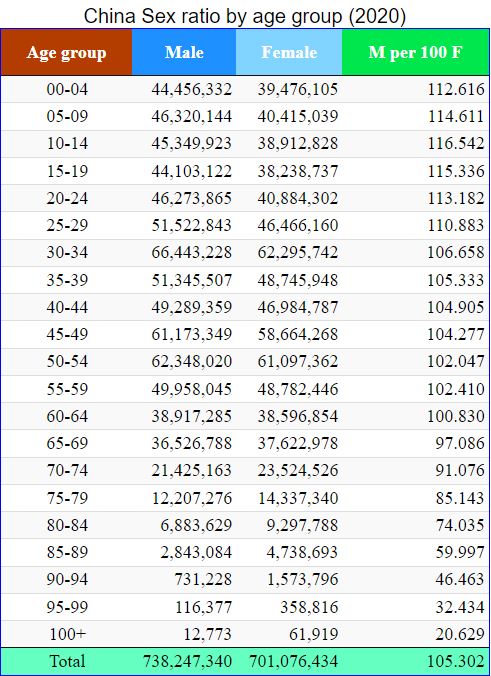When I was in Beijing, my tutor was a young lady who was one day younger than my son which, at that time, made her 20 years old. She was an only child, and [un]naturally so — the result of China’s one-child policy, which allowed families to have only one child in an effort to stem the growing population. She was one of the luckier too. The desire to have sons has led to the killing of millions of Chinese girls in the womb since the implementation of that policy. If you can only have one, it’s gotta be a boy.
The ratio of males to females is stunning. While in the US, we sit around 98 male to 100 female, China is skewed significantly in the other direction, with the overall average sitting at just over 105 male to 100 female, and in the 0-44 demographic (the one most affected by the policy, which was implemented in 1979), that average hits 111 and goes as high as 116.5 males to 100 females in the 10-14 age group.

The evidence is disturbing for a couple of reasons. As I mentioned before, it shows a distinct tendency toward the killing of females in the womb. This has consequences, the most obvious of which is all of the lost lives and the huge hole left in the core of China’s demographics. Worldwide, the “natural” birth rate is about 105 male to 100 female. Applying that ratio to China’s population in the 0-44 demographic, there should have been about 423 million women to the actual 445 million men. There are a little over 402 million — a 20 million-woman deficit.
Outside of this stunning data, this has other serious consequence — one of which I’ve been warning for quite some time. The lack of potential marriage partners for millions of Chinese men will turn their thoughts to other endeavors to release the pressures and frustrations of not being able to raise a family of their own. Higher crime rates are only natural, and what’s worrying is that the Chinese government may try to rectify the situation by taking their aggressions out elsewhere — not just within China. If you’ve been following the Chinese military lately, this is not a good thing. When I was much younger, China had what was known as a “brown-water” Navy — not often venturing beyond their territorial waters. And in the Air Forces, their pilots were uncomfortable getting out of sight of land. But thanks to a robust program in espionage and hacking, the Chinese have built a powerhouse military that can make the previous world wars look tame. And they’ve been flexing that muscle more and more lately, particularly in the South China Sea, as well as with pressure on the situation with Taiwan.
The impetus for my thoughts on this have come from a recent New York Times opinion piece. China’s “one-child policy” was modified about 5 years ago to allow for more children, and now their family planning is getting a bit more of an overhaul to get up to 3 children. My thoughts as I was reading the article were originally, “why three?” What makes that the magic number? And the authors of the piece hit on an interesting perspective: “Even when the government eases rules about procreation, it is only confirming that such rules exist — and that they are the party’s to dictate. This, too, is population control, and population control is a foundation of any surveillance state. The Chinese Communist Party simply cannot give that up….Lifting controls over births would be, for the Chinese Communist Party, a tacit admission that its past policies have failed.”
No matter how you slice it, it still comes out bad. I have to laud Beijing for trying to right the problems they’ve created in the past, but the truth is, until they’re willing to give up the idea altogether, they’re only making it worse.
On the bright side though, as China grows in wealth, and as the younger generations grow in the freedom that comes with that wealth (more education, access to more information, a better understanding of the global situation), a long, slow turn in the Chinese situation may happen. China is an incredible country, and hopefully it will truly one day become a People’s Republic.
